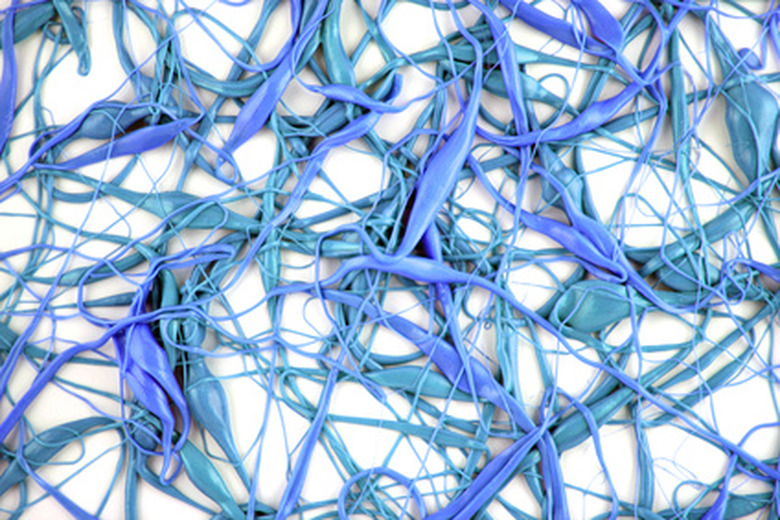Six Types Of Neuroglia
Neuroglia are cells in the central nervous system and the peripheral nervous system. The central nervous system, or CNS, is made up of the brain and spinal cord. The peripheral nervous system, or PNS, is made up of the nerves in the rest of the body.
In fact, along with neurons, they comprise the two types of cells in nervous tissue, and are integral to the functioning of the CNS and PNS. Neuroglia play the role of supportive cells to neurons, which are responsible for all nervous system functions.
Glial cells do more than hold the brain together or provide structure, though. Scientific research is revealing an increasing amount about the importance of glial cells for nervous system function.
TL;DR (Too Long; Didn't Read)
Neuroglia operate as support cells to neurons in the central and peripheral nervous systems. There are six types of neuroglia, each with different functions:
* Astrocyte
* Oligodendrocyte
* Microglia
* Ependymal cell
* Satellite cell
* Schwann cell
The Function of Neurons
The Function of Neurons
There are trillions of neurons in the human nervous system. These cells are largely responsible for the functions that are traditionally thought of as the activities of the brain.
They conduct electrical signals, which are called action potentials. These are transmitted across the gap between neurons by the release and uptake of chemicals called neurotransmitters.
These neuronal chemical and electrical signals operate as a communication system that orchestrates all of the functions of the nervous system. Some examples of what the nervous system controls are:
- Breathing
- Metabolic control
- Movement
- Speech
- Behavior
- Complex reasoning
Communication happens so rapidly that it seems instantaneous.
Types of Neuroglia
Types of Neuroglia
Neuroglia are categorized into six subtypes. Four of them are present in the CNS:
- Astrocyte
- Oligodendrocyte
- Microglia
- Ependymal cell
Two of them are present in the PNS:
- Satellite cell
- Schwann cell
Satellite cells function to provide nutrients and protection to neurons in the PNS. A satellite glial cell wraps itself around the neuron's cell body. The cell body is a rounded section that contains the nucleus and other key organelles common to most somatic cells.
Schwann cells wrap themselves around the axons of neurons in the PNS. The axon is the long, thin part of the neuron, along which the electrical signal passes. The Schwann cell forms a protective layer called the myelin sheath – this operates like the insulated coating on electrical wiring. Without it, the electrical signal can be disrupted, slowed or stopped altogether.
Neuroglia in the Central Nervous System
Neuroglia in the Central Nervous System
Astrocytes are one of the four types of glia in the CNS. They provide protection and support to neurons, exchanging nutrients and other important chemicals.
Astro is the Greek root word for "star." They have many cell extensions called processes, used for chemical exchanges, that branch out like the points of stars.
These processes connect with neurons, other types of tissue such as blood vessels in the brain or spine, or importantly, the blood brain barrier. The blood brain barrier is a protective membrane surrounding the spine and brain.
The blood brain barrier allows small molecules such as respiratory gases to pass through, while blocking anything larger. Medical and pharmaceutical researchers making drugs that need to reach the brain have to ensure that they have a way for their medicine to cross the blood brain barrier.
Oligodendrocytes and Myelin Sheaths
Oligodendrocytes and Myelin Sheaths
Oligodendrocytes wrap around the axons of CNS neurons to provide electrical insulation called myelin sheaths. This allows the signal to move quickly enough for proper functioning. In many neurodegenerative diseases, the myelin sheaths are damaged.
For example, multiple sclerosis is a chronic autoimmune disease in which the immune system mistakenly attacks and scars the myelin sheaths. These scars slow the signals of the affected neurons. Depending on where in the CNS the neurons are, symptoms can include problems with movement, sensation and speech, among others.
Ependymal Cells and Microglia
Ependymal Cells and Microglia
Partitioned by the blood brain barrier, the brain and spine need their own kind of circulatory fluid. This clear fluid is called cerebrospinal fluid, or CSF for short.
Glia called ependymal cells line the empty cavities called ventricles in the brain and have access to nearby blood vessels. They filter some of the materials out of the vessels to manufacture CSF and then use their cilia to circulate it through the empty ventricles and into the rest of the CNS.
The final type of glial cell are small ones called microglia. Like **macrophages** in the blood, they surround and digest damaged or invading cells. They are considered the immune cells of the CNS.
Cite This Article
MLA
E., Rebecca. "Six Types Of Neuroglia" sciencing.com, https://www.sciencing.com/six-types-neuroglia-6302092/. 24 June 2019.
APA
E., Rebecca. (2019, June 24). Six Types Of Neuroglia. sciencing.com. Retrieved from https://www.sciencing.com/six-types-neuroglia-6302092/
Chicago
E., Rebecca. Six Types Of Neuroglia last modified August 30, 2022. https://www.sciencing.com/six-types-neuroglia-6302092/
